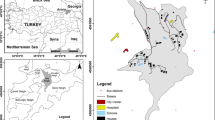Abstract
House price indexes had become important economic indicators worldwide, since movements in house prices have been closely correlated with the economic cycle. In order to compute these kind of indexes it is imperative to produce reliable estimates of the average transaction price of houses, not only at the macrolevel (e.g. national and state level), but also at the microlevel (e.g. district, municipalities or further disaggregate regional level). In Portugal, there is a rapidly growing demand of such microlevel statistics since the beginning of the recent financial and economic crisis. The Portuguese Statistical Office provides a range of invaluable data at national level; however, this data cannot be used directly to produce reliable regional-level estimates due to small sample sizes. In this paper we employ small area estimation techniques to produce design and model-based estimates of average transaction price of houses for Portuguese regions with small sample sizes. Our results show that the model-based estimates based on spatial and temporal models are more accurate than the traditional direct design-based estimates. The use of these techniques allows the production of information at disaggregated regional levels that would not be available under the traditional direct estimation approaches. Furthermore, it is even possible to produce reliable model-based estimates for geographical areas without sample. The estimates are expected to provide invaluable information to policy-analysts and decision-making.




Similar content being viewed by others
Notes
In Europe, states are divided into administrative regions called NUTS (Nomenclature of Units for Territorial Statistics) for statistical purposes. In particular, Portugal is divided into five NUTSII areas, 28 NUTSIII areas and 278 NUTSIV areas (municipalities).
References
Anselin L (1992) Spatial econometrics: methods and models. Kluwer, Boston, MA
Butar FB, Lahiri P (2003) On measures of uncertainty of empirical Bayes small area estimators. J Stat Plan Inference 112:63–76
Chandra H, Salvati N, Chambers R (2007) Small area estimation for spatially correlated populations—a comparison of direct and indirect model-based methods. Stat Transit New Ser 8:331–350
Chen S, Lahiri P (2008) On mean squared prediction error estimation in small area estimation problems. Commun Stat Theory Methods 37:1792–1798
Cliff AD, Ord JK (1981) Spatial processes: models and applications. Pion Press, London
Cressie N (1991) Small-area prediction of undercount using the general linear model. In: Proceedings of the statistic symposium 90: measurement and Improvement of data quality, Statistics Canada
Datta GS, Lahiri P (2000) A unified measure of uncertainty of estimated best linear unbiased predictors in small area estimation problems. Stat Sin 10:613–627
Datta GS, Rao JNK, Smith DD (2005) On measuring the variability of small area estimators under a basic area level model. Biometrika 92:183–196
Demidenko E (2004) Mixed models: theory and applications. Wiley, New York, NY
Fay RE, Herriot RA (1979) Estimates of income for small places: an application of James–Stein procedures to census data. J Am Stat Assoc 74:269–277
Fuller WA, Battese GE (1973) Transformations for estimation of linear models with nested-error structure. J Am Stat Assoc 68:626–632
Ghosh M, Rao JNK (1994) Small area estimation: an appraisal. Stat Sci 9:55–93
Girouard N, Blöndal S (2001) House prices and economic activity. OECD Economics Department working paper no. 279, Paris
Henderson CR (1953) Estimation of variance and covariance components. Biometrics 9:226–252
Henderson CR (1975) Best linear unbiased estimation and prediction under a selection model. Biometrics 31:423–447
Jiang J, Lahiri P (2006) Mixed model prediction and small area estimation. Test 15:1–96
Jiang J, Lahiri P, Wan S-M (2002) A unified jackknife theory for empirical best prediction with M-estimation. Ann Stat 30:1782–1810
Lahiri P, Rao JNK (1995) Robust estimation of mean squared error of small area estimators. J Am Stat Assoc 90:758–766
Molina I, Salvati N, Pratesi M (2009) Bootstrap for estimating the MSE of the spatial EBLUP. Comput Stat 24:441–458
Moran PAF (1950) Notes on continous stochastic phenomena. Biometrika 37:17–23
Pereira LN (2009) Estimação em pequenos domínios com modelos espaciotemporais de nível área. PhD thesis, Univ Algarve. http://hdl.handle.net/10400.1/606. Accessed 3 Jan 2012
Pereira LN, Coelho PS (2010) Assessing different uncertainty measures of EBLUP: a resampling-based approach. J Stat Comput Simul 80:713–727
Petrucci A, Pratesi M, Salvati N (2005) Geographic information in small area estimation: small area models and spatially correlated random area effects. Stat Transit 7:609–623
Petrucci A, Salvati N (2006) Small area estimation for spatial correlation in watershed erosion assessment. J Agric Biol Environ Stat 11:169–182
Pfeffermann D (2002) Small area estimation—new developments and directions. Int Stat Rev 70:125–143
Prasad NGN, Rao JNK (1990) The estimation of the mean squared error of small-area estimators. J Am Stat Assoc 85:163–171
Pratesi M, Salvati N (2008) Small area estimation: the EBLUP estimator based on spatially correlated random area effects. Stat Methods Appl 17:113–141
Pratesi M, Salvati N (2009) Small area estimation in the presence of correlated random area effects. J Off Stat 25:37–53
Rao JNK (2003) Small area estimation. Wiley, Hoboken, NJ
Rao JNK, Yu M (1994) Small-area estimation by combining time-series and cross-sectional data. Can J Stat 22:511–528
Salvati N (2004) Small area estimation by spatial models: the spatial empirical best linear unbiased prediction (spatial EBLUP). Working paper 2004/03. Univ degli Studi Firenze, Firenze
SAMPLE Project (2010) Final small area estimation developments and simulation results. http://www.sample-project.eu/images/stories/docs/samplewp2d1216_saefinal.pdf. Accessed 3 Jan 2012
Verbeke G, Molenberghs G (2000) Linear mixed models for longitudinal data. Springer, New York, NY
Wolter KM (2007) Introduction to variance estimation. Springer, New York, NY
Woodruff RS (1971) A simple method for approximating the variance of a complicated estimate. J Am Stat Assoc 66:411–414
Acknowledgments
The authors acknowledge the Portuguese Statistical Office for the availability of the data used in the research. The views expressed here are solely those of the authors. The authors also thank the Fundação para a Ciência e a Tecnologia (FCT).




